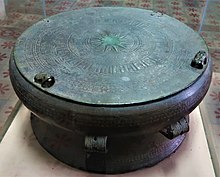Our website is made possible by displaying online advertisements to our visitors.
Please consider supporting us by disabling your ad blocker.
Drum





The drum is a member of the percussion group of musical instruments. In the Hornbostel-Sachs classification system, it is a membranophone.[1] Drums consist of at least one membrane, called a drumhead or drum skin, that is stretched over a shell and struck, either directly with the player's hands, or with a percussion mallet, to produce sound. There is usually a resonant head on the underside of the drum. Other techniques have been used to cause drums to make sound, such as the thumb roll. Drums are the world's oldest and most ubiquitous musical instruments, and the basic design has remained virtually unchanged for thousands of years.[1]
Drums may be played individually, with the player using a single drum, and some drums such as the djembe are almost always played in this way. Others are normally played in a set of two or more, all played by one player, such as bongo drums and timpani. A number of different drums together with cymbals form the basic modern drum kit.
- ^ a b Grove, George (January 2001). Stanley Sadie (ed.). The New Grove Encyclopædia of Music and Musicians (2nd ed.). Grove's Dictionaries of Music. pp. Volume 5, pp638–649. ISBN 978-1-56159-239-5.
Previous Page Next Page


